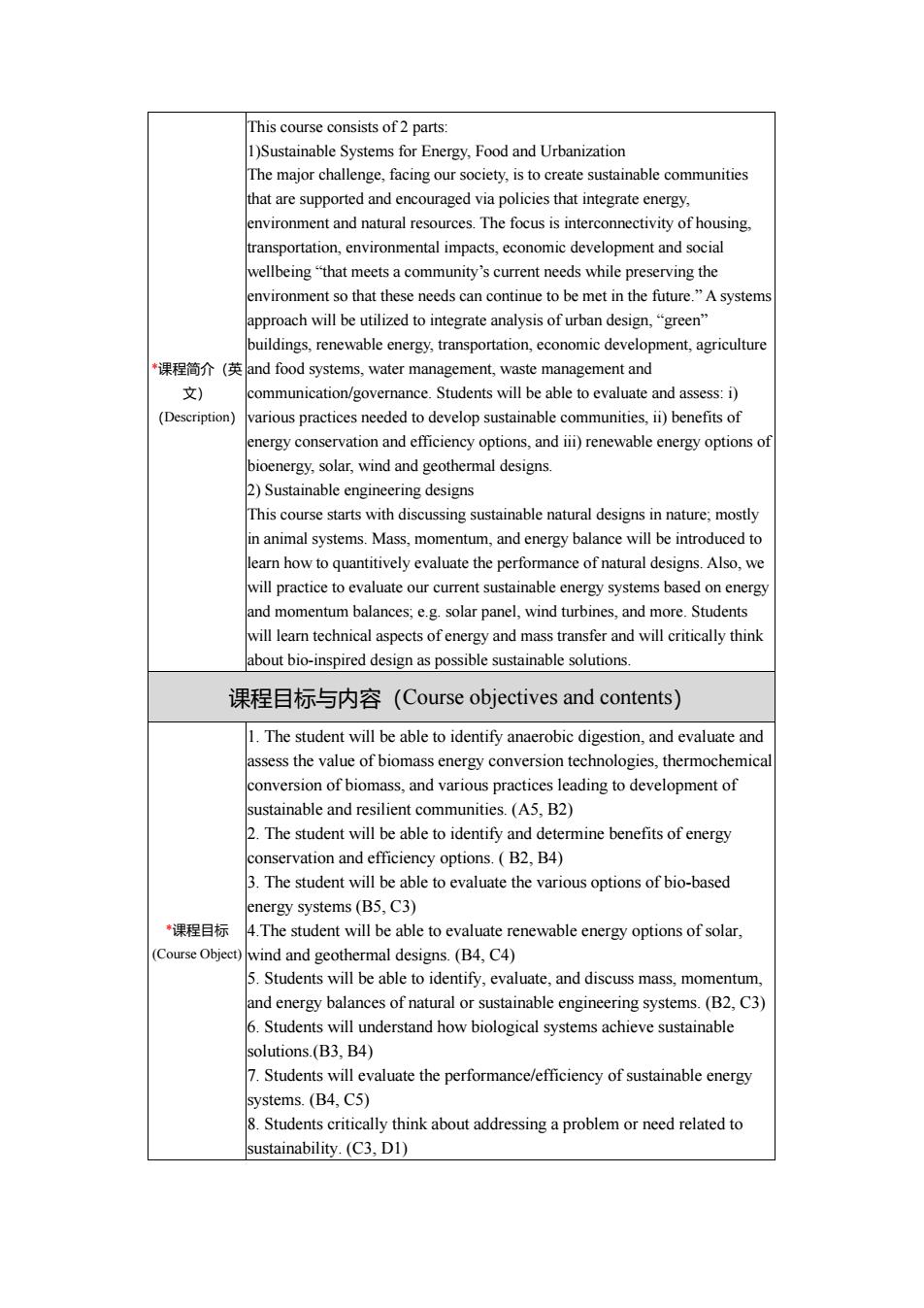正在加载图片...

This course consists of2 parts 1)u Systemr Energy, The major challenge,facing our society,is to create sustainable communities hat are supported and encouraged via policies that integrate energy. environment and natural resources.The focus is interconnectivity of housing. transportation,environmental impacts,economic development and social rving the environment so that these needs can continue to be met in the future. A system approach will be utilized to integrate analysis of urban design,"green' buildings,renewable energy,transportation,economic development,agriculture *课程简介(英and food systems,water management,.waste management and mmunication/govemance.Students will be able to evaluate and assess:i) (De arious practice edd sustainablecom)of energy conservation and efficiency options,and iii)renewable energy options of bioenergy,solar,wind and geothermal designs. 2)Sustainable engineering designs This with discussing sustainable natural mostly inanimal systems.Mass,momentum,and eery balance will be introduced t earn how to quantitively evaluate the performance of natural designs.Also,we will practice to evaluate our current sustainable energy systems based on energ and momentum balances,e.g.solar panel,wind turbines,and more.Students will learn technical aspects of energy and mass transfer and will critically think 课程目标与内容(Course objectives and contents) 1.The student will be able to identify anaerobic digestion,and evaluate and ess the value of bi s energy conversion technologies,thermochem conversion of biomass,and various practices leading to development of sustainable and resilient communities.(A5.B2) 2.The student will be able to identify and determine benefits of energy conservation and efficiency options.(B2,B4) 3.The student will be able to evaluate the various options of bio-based energy systems(B5,C3) “课程目标 4.The student will be able to evaluate renewable energy options of solar. (Course Object)wind and geothermal designs.(B4,C4) 5.Students will be able to identify,evaluate,and discuss mass,momentum and energy balances of natural or sustainable engineering systems.(B2.C3) 6.Student will under stand how biologicl systems achieve sustainable solutions.(B3.B4) 7.Students will evaluate the performance/efficiency of sustainable energy systems.(B4.C5) 8.Students critically think about addressing a problem or need related to sustainability.(C3.D1)*课程简介(英 文) (Description) This course consists of 2 parts: 1)Sustainable Systems for Energy, Food and Urbanization The major challenge, facing our society, is to create sustainable communities that are supported and encouraged via policies that integrate energy, environment and natural resources. The focus is interconnectivity of housing, transportation, environmental impacts, economic development and social wellbeing “that meets a community’s current needs while preserving the environment so that these needs can continue to be met in the future.” A systems approach will be utilized to integrate analysis of urban design, “green” buildings, renewable energy, transportation, economic development, agriculture and food systems, water management, waste management and communication/governance. Students will be able to evaluate and assess: i) various practices needed to develop sustainable communities, ii) benefits of energy conservation and efficiency options, and iii) renewable energy options of bioenergy, solar, wind and geothermal designs. 2) Sustainable engineering designs This course starts with discussing sustainable natural designs in nature; mostly in animal systems. Mass, momentum, and energy balance will be introduced to learn how to quantitively evaluate the performance of natural designs. Also, we will practice to evaluate our current sustainable energy systems based on energy and momentum balances; e.g. solar panel, wind turbines, and more. Students will learn technical aspects of energy and mass transfer and will critically think about bio-inspired design as possible sustainable solutions. 课程目标与内容(Course objectives and contents) *课程目标 (Course Object) 1. The student will be able to identify anaerobic digestion, and evaluate and assess the value of biomass energy conversion technologies, thermochemical conversion of biomass, and various practices leading to development of sustainable and resilient communities. (A5, B2) 2. The student will be able to identify and determine benefits of energy conservation and efficiency options. ( B2, B4) 3. The student will be able to evaluate the various options of bio-based energy systems (B5, C3) 4.The student will be able to evaluate renewable energy options of solar, wind and geothermal designs. (B4, C4) 5. Students will be able to identify, evaluate, and discuss mass, momentum, and energy balances of natural or sustainable engineering systems. (B2, C3) 6. Students will understand how biological systems achieve sustainable solutions.(B3, B4) 7. Students will evaluate the performance/efficiency of sustainable energy systems. (B4, C5) 8. Students critically think about addressing a problem or need related to sustainability. (C3, D1)